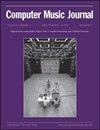计算机音乐史的一部分…(相信我,拉丁美洲一直都在那里!)
IF 0.4
Q4 COMPUTER SCIENCE, INTERDISCIPLINARY APPLICATIONS
引用次数: 0
摘要
摘要几十年来,大多数拉丁美洲国家的政治和经济不稳定一直深刻影响着其居民的生活。为了解决紧迫的社会问题,对艺术活动的支持通常被推迟。尽管如此,这些国家的电子艺术,尤其是电声和计算机音乐的发展令人震惊。Mauricio Kagel、Reginaldo Carvalho、Hilda Dianda、Juan Amenabar、Horacio Vaggione、Jorge Antunes、Jocy de Oliveira、JoséVicente Asuar和Juan Blanco只是拉丁美洲电声音乐创意海洋中众多名字中的一部分。存档和传播电子艺术,并对其历史进行修订,对于理解现在和建设我们的未来至关重要。拉丁美洲电声音乐收藏由蒙特利尔的Daniel Langlois艺术、科学和技术基金会主办,收藏了近400位作曲家在1957年至2007年间创作的1700多首作品的数字录音。该系列已经恢复并使许多作曲家的创作作品可见(并列表),否则几乎被遗忘。它挑战了计算机和电声音乐历史叙事的霸权,帮助打破了障碍,拓宽了人们对其历史的理解。本文章由计算机程序翻译,如有差异,请以英文原文为准。
Part of Computer Music History… (Trust Me, Latin America Has Always Been There!)
Abstract The political and economic instability in most Latin American countries has been profoundly affecting the lives of its inhabitants for decades. Support for artistic activities has usually been postponed to solve urgent social problems. Despite that, the development in these countries of the electronic arts, in general, and electroacoustic and computer music, in particular, is astounding. Mauricio Kagel, Reginaldo Carvalho, Hilda Dianda, Juan Amenabar, Horacio Vaggione, Jorge Antunes, Jocy de Oliveira, José Vicente Asuar, and Juan Blanco are only some of the many names in the ocean of electroacoustic music creativity that has always been Latin America. Archiving and disseminating electronic art—and working on a revised version of its history—is crucial to comprehend the present and build our future. The Latin American Electroacoustic Music Collection, hosted by the Daniel Langlois Foundation for Art, Science, and Technology in Montreal, has over 1,700 digital recordings of compositions created between 1957 and 2007 by almost 400 composers. The Collection has recovered and made visible (and listenable) the creative work of many composers otherwise almost forgotten. It has defied the hegemony of the computer and electroacoustic music history narrative, helping to break barriers and widening the way their history is understood.
求助全文
通过发布文献求助,成功后即可免费获取论文全文。
去求助
来源期刊

Computer Music Journal
工程技术-计算机:跨学科应用
CiteScore
1.80
自引率
0.00%
发文量
2
审稿时长
>12 weeks
期刊介绍:
Computer Music Journal is published quarterly with an annual sound and video anthology containing curated music¹. For four decades, it has been the leading publication about computer music, concentrating fully on digital sound technology and all musical applications of computers. This makes it an essential resource for musicians, composers, scientists, engineers, computer enthusiasts, and anyone exploring the wonders of computer-generated sound.
Edited by experts in the field and featuring an international advisory board of eminent computer musicians, issues typically include:
In-depth articles on cutting-edge research and developments in technology, methods, and aesthetics of computer music
Reports on products of interest, such as new audio and MIDI software and hardware
Interviews with leading composers of computer music
Announcements of and reports on conferences and courses in the United States and abroad
Publication, event, and recording reviews
Tutorials, letters, and editorials
Numerous graphics, photographs, scores, algorithms, and other illustrations.
 求助内容:
求助内容: 应助结果提醒方式:
应助结果提醒方式:


